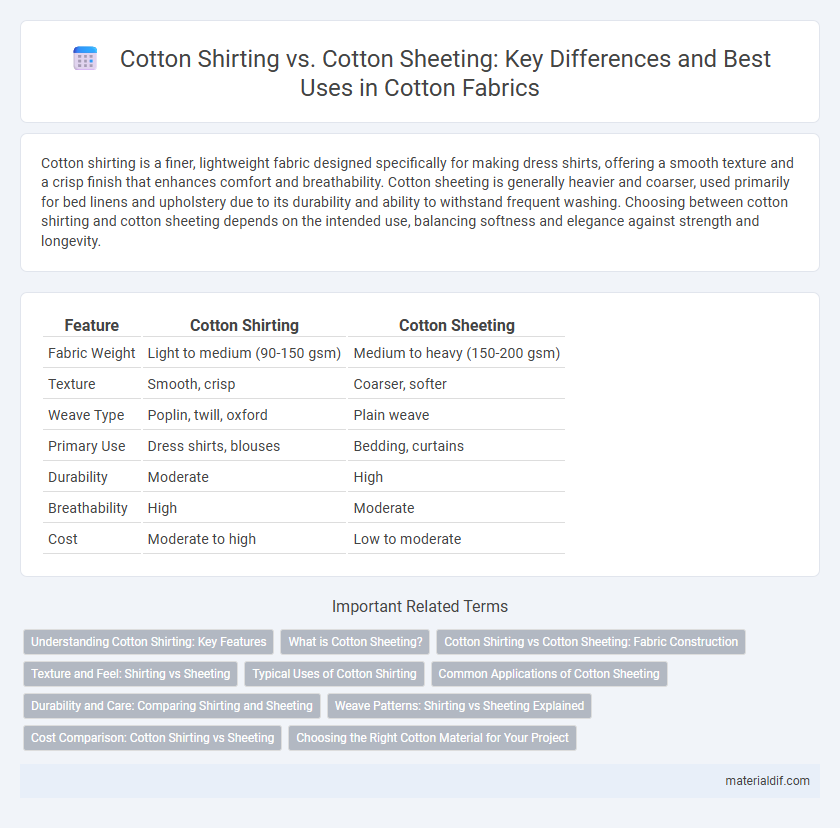Cotton shirting is a finer, lightweight fabric designed specifically for making dress shirts, offering a smooth texture and a crisp finish that enhances comfort and breathability. Cotton sheeting is generally heavier and coarser, used primarily for bed linens and upholstery due to its durability and ability to withstand frequent washing. Choosing between cotton shirting and cotton sheeting depends on the intended use, balancing softness and elegance against strength and longevity.
Table of Comparison
| Feature | Cotton Shirting | Cotton Sheeting |
|---|---|---|
| Fabric Weight | Light to medium (90-150 gsm) | Medium to heavy (150-200 gsm) |
| Texture | Smooth, crisp | Coarser, softer |
| Weave Type | Poplin, twill, oxford | Plain weave |
| Primary Use | Dress shirts, blouses | Bedding, curtains |
| Durability | Moderate | High |
| Breathability | High | Moderate |
| Cost | Moderate to high | Low to moderate |
Understanding Cotton Shirting: Key Features
Cotton shirting fabric is characterized by its lightweight and smooth texture, making it ideal for tailored shirts and garments requiring a crisp appearance. It typically features a tighter weave and higher thread count compared to cotton sheeting, resulting in enhanced durability and a refined finish. This fabric is often treated for improved wrinkle resistance and breathability, ensuring both comfort and style in formal and casual wear.
What is Cotton Sheeting?
Cotton sheeting refers to a lightweight, plain-weave cotton fabric commonly used for bed linens, offering a smooth texture that balances breathability and durability. Unlike cotton shirting, which is typically heavier and designed specifically for garments, cotton sheeting emphasizes comfort and softness to enhance sleep quality. Its high thread count and tightly woven fibers make cotton sheeting resistant to wear while maintaining a crisp, clean finish suitable for various household textiles.
Cotton Shirting vs Cotton Sheeting: Fabric Construction
Cotton shirting fabric features a tighter weave with a smoother finish, designed specifically to provide durability and a crisp appearance ideal for shirts. Cotton sheeting fabric has a more open weave and a softer texture, offering breathability and comfort typically used for bed linens and lightweight garments. The distinct weave density and thread count in cotton shirting versus cotton sheeting directly influence their respective strength, texture, and suitability for different applications.
Texture and Feel: Shirting vs Sheeting
Cotton shirting fabric features a smooth, lightweight texture with a crisp feel ideal for tailored shirts, offering breathability and softness against the skin. In contrast, cotton sheeting is typically coarser and heavier, providing durability and a denser weave suited for bedding and upholstery. The distinct textures result from differing thread counts and finishing processes, where shirting emphasizes fine, tightly woven threads for a polished look, while sheeting prioritizes sturdiness and comfort.
Typical Uses of Cotton Shirting
Cotton shirting is specifically designed for lightweight, breathable apparel, making it ideal for dress shirts, blouses, and casual wear that require comfort and crisp appearance. It typically features a tighter weave and finer yarns compared to cotton sheeting, which is often softer and used mainly for bed linens and upholstery. The durability and smooth texture of cotton shirting ensure it holds collars and cuffs well, catering to fashion and formal clothing designs.
Common Applications of Cotton Sheeting
Cotton sheeting is primarily used in home textiles such as bed linens, pillowcases, and lightweight curtains due to its smooth texture and durability. Its tightly woven structure provides strength and resistance to wear, making it ideal for everyday household use. Compared to cotton shirting, which is designed for apparel with a softer, more breathable finish, cotton sheeting is favored for functional, long-lasting fabric needs in bedding and upholstery.
Durability and Care: Comparing Shirting and Sheeting
Cotton shirting fabric is typically woven with a tighter weave, offering enhanced durability and resistance to frequent wear compared to cotton sheeting, which has a looser weave designed for softness rather than toughness. Shirting cotton often requires less maintenance, maintaining its shape and color after multiple washes, while sheeting cotton may show signs of wear or pilling more quickly. Proper care for both fabrics involves gentle washing and air drying to extend fabric lifespan and preserve quality.
Weave Patterns: Shirting vs Sheeting Explained
Cotton shirting features a tighter, finer weave pattern, typically a plain or twill weave, designed for lightweight, breathable fabrics ideal for dress shirts. Cotton sheeting employs a coarser, more balanced plain weave that provides durability and a smooth surface, primarily used for bed linens and household textiles. The difference in weave density and texture directly impacts the fabric's softness, strength, and suitability for apparel versus home goods.
Cost Comparison: Cotton Shirting vs Sheeting
Cotton shirting fabric generally costs more than cotton sheeting due to its finer weave, higher thread count, and smoother finish, which are essential for apparel quality and comfort. Cotton sheeting fabric is more affordable and commonly used for bedding and home textiles because of its coarser texture and lower thread density. The price difference reflects the functional requirements and manufacturing processes unique to shirting and sheeting cotton types.
Choosing the Right Cotton Material for Your Project
Cotton shirting fabric offers a durable, smooth finish ideal for tailored shirts and garments requiring fine drape, while cotton sheeting is a lightweight, plain weave fabric suited for bedding and utilitarian uses. Selecting the right cotton material depends on thread count, weave type, and desired texture to ensure the fabric meets project needs for comfort, breathability, and durability. Understanding fiber length and fabric weight helps optimize performance for both fashion and home textile applications.
Cotton Shirting vs Cotton Sheeting Infographic

 materialdif.com
materialdif.com